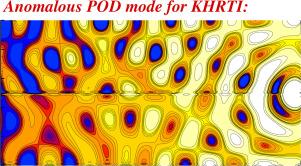Comparing the highly-resolved onset of Rayleigh–Taylor and Kelvin–Helmholtz Rayleigh–Taylor instabilities
IF 2.5
3区 工程技术
Q2 MECHANICS
引用次数: 0
Abstract
The present study explores onset of Rayleigh–Taylor instability (RTI) and Kelvin–Helmholtz Rayleigh–Taylor instability (KHRTI) with highly-resolved direct numerical simulations of two setups considering air at different temperatures (or densities) and/or velocities in two halves of three-dimensional (3D) cuboidal domains. The RTI and KHRTI are simulated with 4.2 billion and 480 million mesh points, respectively. Here, we do not impose any external perturbation similar to the unforced experiments of RTI and KHRTI. The compressible Navier–Stokes equations are solved using a novel parallel algorithm which does not involve overlapping points at sub-domain boundaries. This removes the errors at sub-domain boundaries and provides same level of accuracy as sequential computing. The pressure disturbance field is compared during onset of RTI and KHRTI and corresponding convection- and advection-dominated mechanisms are highlighted by instantaneous features, spectra, and proper orthogonal decomposition. Relative contributions of pressure energy, kinetic energy and rotational energy to overall energy budget are explored, revealing acoustics to play a central role in initial perturbation for both RTI and KHRTI. The nonlinear, spatio-temporal nature of the instability is further explored by application of a transport equation for enstrophy of compressible flows. This provides insights into the similarities and differences between onset mechanisms of RTI and KHRTI, serving as a benchmark data set for shear and buoyancy-driven instabilities across diverse applications in geophysics, nuclear energy and atmospheric fluid dynamics.

比较瑞利-泰勒不稳定性和开尔文-亥姆霍兹瑞利-泰勒不稳定性的高分辨起始
本研究探讨了瑞利-泰勒不稳定性(RTI)和开尔文-亥姆霍兹瑞利-泰勒不稳定性(KHRTI)的发生,采用高分辨率的直接数值模拟,考虑了空气在不同温度(或密度)和/或速度下在三维(3D)立方体区域的两半。RTI和KHRTI分别用42亿个和4.8亿个网格点进行模拟。在这里,我们没有施加任何类似于RTI和KHRTI的非强制实验的外部扰动。采用一种新的并行算法求解可压缩Navier-Stokes方程,该算法不涉及子域边界上的重叠点。这消除了子域边界处的错误,并提供了与顺序计算相同的精度。比较了RTI和KHRTI开始时的压力扰动场,并通过瞬时特征、光谱和适当的正交分解突出了相应的对流和平流主导机制。研究了压力能、动能和旋转能对总能量收支的相对贡献,揭示了声学在RTI和KHRTI的初始摄动中起着核心作用。通过应用可压缩流的熵输运方程,进一步探讨了不稳定性的非线性、时空性质。这提供了对RTI和KHRTI发生机制的异同的见解,可以作为地球物理、核能和大气流体动力学等不同应用中剪切和浮力驱动不稳定性的基准数据集。
本文章由计算机程序翻译,如有差异,请以英文原文为准。
求助全文
约1分钟内获得全文
求助全文
来源期刊
CiteScore
5.90
自引率
3.80%
发文量
127
审稿时长
58 days
期刊介绍:
The European Journal of Mechanics - B/Fluids publishes papers in all fields of fluid mechanics. Although investigations in well-established areas are within the scope of the journal, recent developments and innovative ideas are particularly welcome. Theoretical, computational and experimental papers are equally welcome. Mathematical methods, be they deterministic or stochastic, analytical or numerical, will be accepted provided they serve to clarify some identifiable problems in fluid mechanics, and provided the significance of results is explained. Similarly, experimental papers must add physical insight in to the understanding of fluid mechanics.

 求助内容:
求助内容: 应助结果提醒方式:
应助结果提醒方式:


